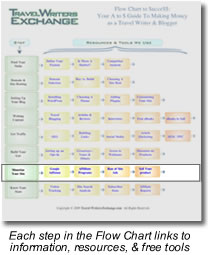If you’re wondering what this Case Study is all about, please read the introductory post from Week One.
Last week we talked about Affiliate Advertising, and how Suzy has started placing relevant ads on her travel blog, which, as she builds significant site traffic, will start to earn her affiliate revenue.
This week we’ll discuss Direct Advertising Agreements.
This is a broad term that covers all forms of advertising that don’t fall into the AdSense or Affiliate Program models. However, it’s a bit trickier as it requires you to negotiate terms and set your own rates, but in the long run can be quite lucrative.
A Direct Advertising Program generally falls into one of four revenue models:

- A flat monthly rate for space based on ad size and positioning;
- A Cost Per Click where you earn money each time a site visitor clicks through to the advertiser’s site from their ad on your travel blog;
- A Cost Per Lead – this can involve either a click-through or customers getting to the advertiser via a form on your site, or a special toll-free number you advertise for them, or a coupon code that is exclusive to you;
- A Cost Per Sale – this requires that some purchase be made at the advertiser’s site (that is tracked to you) before you earn anything;
The second two methods are more advanced and require much more work to track, so I advise you to consider those arrangements only after you have a lot of experience with Direct Advertising Programs under your belt. We will be writing a future post on the second two methods for anyone who is interested.
Suzy’s already been approached by several advertisers to do some direct ads on her site, and she’s working through how to determine ad rates and to make sure she’s finding or approving appropriate matches.
Finding Direct Advertisers
If the travel niche that you write about on your travel blog is sailing (whether that’s your own sailboat, chartering a boat, or simply going on the popular “barefoot cruises”) then advertisers such as sailboat manufacturers, sailboat charter companies, or sailboat equipment distributors might be interested in placing an ad on your site for a monthly or annual fee.
Do you blog about a specific destination? Consider a locally owned hotel or Bed & Breakfast, or a ticket broker for local events. The CVB for that destination can often help you identify potential local advertisers. The point is to get creative. Then get aggressive.
By “aggressive” I mean simply taking the initiative to contact a potential direct advertiser. Be prepared to provide them with advertising rates and statistics about your travel blog, including monthly visitor counts, subscriber counts, click-through rate (from other links on your site), and your social media reach (we’ll be discussing how to monitor and understand your site stats beginning in Week 18 of this Case Study).
Setting Your Ad Rates
Primary factors include your number of monthly site visitors (including unique visitors), page views, placement (banner, sidebar, above the fold or not), and the size of the ad. Secondary factors include your Google PageRank, how many other outbound links (of the “dofollow” type) you already have on your typical pages (which determines how much link rank they’ll receive from you), and your average click-through rate for other ads and links on your site.
Spend some time getting familiar with your site’s metrics, and use the free tools offered by Google, such as the Google Keyword Research Tool, which will also tell you the average per-click spend by advertisers for your top keywords. Knowing this, and your site’s average click-through rate, will help you arrive at fair rates for either the first or second model listed above.
Doing the math: Model #1, a Flat Monthly Fee is based on your monthly site traffic. While large sites with high traffic numbers (500k to a million or more visitors per month) can charge monthly ad rates that range from $500 to $1,500, at least part of that rate comes from their credibility, the strength of their brand, and their high Google PageRank.
One example is a website I’ve done some consulting for that charges more than twenty-thousand dollars per month per ad, however that is based on the fact that they have nearly 2 million unique visitors monthly AND a much-higher-than-average click-through rate because of their very tightly focused niche.
For the average blogger with 5k to 15k monthly visitors, a good rule of thumb is to start at .50 (fifty cents) per thousand site visitors, a little higher for banner ads, and calculate a monthly rate from that. If your travel blog is niche-focused and you’re ranking well for some of your top keywords, and you’ve found an advertiser that is a great fit, you can start out with a bit higher rate, particularly if the traffic you send them is targeted and highly valuable to them.
Model # 2, a Cost Per Click, is based on your monthly number of site visitors, your average click-through rate, and what your advertiser would, on average, spend to get a visitor to their site via Google AdWords. Any higher than the average spend, and your advertiser could be better off with Google. Lower and you’re underselling your space.
Monitor your site’s traffic and click-through performance, and re-evaluate every few months to see if it’s feasible to raise your rates as your numbers improve.
A few tips for managing Direct Advertising
Much of the advice from last week’s post about Affiliate Advertising Programs also applies to Direct Advertising programs, so you may want to take note of those tips, and keep these in mind as well:
- Don’t be afraid to offer only short-term agreements for prime space so you can test what works and what doesn’t;
- Don’t list your advertising rates on your site, but do have a page that lists some key metrics and benefits for potential advertisers, with a method that they can contact you if interested (a contact form or email address);
- Don’t wait for advertisers to come knocking on your door – if you identify one as a good fit for your travel blog, send a brief introductory email to their marketing person, and include just a few key reasons why you think your travel blog would be a good place for them to advertise;
Stay tuned! Next week we’ll discuss how Suzy could write and sell her own eBooks as another revenue source.
~Trisha
Are you selling Direct Ads on your travel blog? Share your experience!






Great post about direct advertising. Most writes have difficulty setting their writing rates. Thanks for the guidelines for advertising rates, it helps!
Trisha, again with the great advice!
I cant tell you how valuable this series has been to me!
Thanks again looking forward to next week!
.-= Marcus Adkins´s last blog post: Florida Trail Thru-Hike Day 6 “Trip and Fall” =-.
Very nice article! Just wanted to pass a link that I think is really well written regarding ‘direct advertising’ that breaks it down based on blogging level (e.g., beginner, novice, expert, etc…)
http://www.blogussion.com/monetization/make-money-online-blogging/
Great tips, Trisha. Your series of articles is a wonderful resource for aspiring bloggers, and those wishing to improve their site, and take it to the next level of professionalism. Thank you for sharing your knowledge and experience.
.-= Mary Ann G´s last blog post: Rick Steves – Travel as a Political Act =-.
Thank you for such a nice compliment, Mary Ann – I really appreciate knowing that the case study is helping other people!
Another excellent post in this series. THANK YOU (not angry, just a big thank you) for sharing your knowledge and experience with us. As a newbie, this type of ‘straight-talk’ can be hard to come by.
.-= Todd´s last blog post: Peru Trip Report – October 2009 =-.
Thanks. Another great post. This whole entire series has been extremely helpful. So..how many monthly visitors do I need before I start thinking about direct advertising (the flat monthly rate) …at least 5k?
Hi Stephen
At 5k you’re starting to get to where advertisers will take you more seriously BUT the bottom line is that it’s less about the actual number of monthly visitors than it is about how targeted your numbers are for them…
For example, a pet food manufacturer would sure love to reach pet owners so if you blog about traveling with pets, you’re providing them with a highly targeted market. Reaching 100 pet-owning site visitors a day is much more attractive to them than reaching 1,000 site visitors who may or may not be pet owners.
Of course what you charge for advertising should be relevant to both the narrowness of your market and the number of visitors.
Trisha thank you for all your advice, greatly appreciated